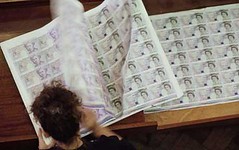
PREV ARTICLE
NEXT ARTICLE
FULL ISSUE
PREV FULL ISSUE
NEWTON AND THE COUNTERFEITER AUTHOR ON MODERN COUNTERFEITING
Thomas Levenson, author of 'Newton and the Counterfeiter’ published an interesting article this week in The Telegraph about the ancient art of counterfeiting and parallels in today's world.
-Editor

On the morning of March 22, 1699 a prisoner in Newgate was brought to the hanging tree at Tyburn, now Marble Arch. He played to the crowd, praying loudly and then placing his own hood over his head before the executioner’s men pulled the ladder out from under him. He dangled, twitching and choking for minutes – the trapdoor gallows would not come into routine use in Britain for another 50 years – until at last he drooped. Thus died William Chaloner, the most notorious counterfeiter of his day, brought to his death by the Warden of the Royal Mint – a former Cambridge don named Isaac Newton. Chaloner’s case marks a key turning point in the history of counterfeiting – one in which money fakery was moving from coining, to the forging of the brand-new forms of paper money just entering circulation in the 1690s. Chaloner took advantage of the shift with astonishing speed. In June 1695, when the first Bank of England notes, starting at £5, were issued, the Bank’s governors believed that the use of marbled paper – rare then, and very expensive – would be sufficient to deter forgers. They were wrong. The rewards were large enough to make it worth Chaloner’s while to put money up front for the costly materials and craftmanship necessary. By August 1695, his false notes were in circulation. Chaloner’s defeat of the Bank’s first anti-counterfeiting measure marked the first shot of what would become a technological arms race between governments and forgers. For the first century, the advantage lay with fakers – and nowhere more spectacularly than in Britain’s North American outposts. The Massachusetts Bay Colony had first issued paper money in 1690. The other gold-and-silver poor territories of British America followed suit. Most colonial notes were poorly printed and anti-counterfeiting measures were generally notional, no more sophisticated than the motto on a New Jersey 30 shilling note that read "To counterfeit this bill is DEATH." And with each colony issuing its own paper, counterfeiters in New York, for example, could produce fake Virginia notes – and if they passed at a discount as "foreign" exchange, who cared? In response, America’s founding scientist, Benjamin Franklin invented a better bank note. Collaborating with nature-artist Joseph Breintnall, Franklin published a collection of metal cuts produced from plaster casts of leaves. Starting in the late 1730s, he and other colonial printers used the leaf designs to create what were, in essence, early security markers on the paper to be used for printing money. With the coming of the digital revolution, high-quality scanners and colour printers became employed. Standard mistakes include using regular, cellulose-based paper instead of rag and failing to touch up scans before printing. Stupidity pops up, too, as in the 2005 case of counterfeiters in Arizona who sent their printer in for repair – with a sheet of fakes still jamming the works. Careful workers do much better, of course. Bleaching and reusing the paper from small denomination bills gets around one major issue. Photo retouching software can improve colour reproduction enormously. Crumpling and wearing false bills can reduce the "feel" difference between false and legitimate money. Digital counterfeiting has become the technique of choice: as late as 1995, less than one per cent of the counterfeit money seized by the US Secret Service was produced on inkjet printers; by 2008, it was 60 per cent. Which leads to the last twist to the story. There is one corner of contemporary counterfeiting in which Chaloner would feel right at home. The last real security innovation added to British coins came in 1662, with the advent of designs milled into the edges of coins. Now, using methods largely unchanged since Chaloner’s day, modern coiners are producing £1 pieces in bulk at a cost of roughly half the face value of the coins. That’s enough of a margin to make the enterprise worthwhile – to the point that as reported by the BBC in September 2008, the Royal Mint estimates that as many as one in 50 circulating £1 coins is a dud. As Ecclesiastes says: there is nothing new under the sun – certainly not in the pursuit of easy money.
To read the complete article, see:
In the pursuit of easy money
(www.telegraph.co.uk/science/6044714/In-the-pursuit-of-easy-money.html)
The Numismatic Bibliomania Society is a non-profit organization promoting numismatic literature. See our web site at coinbooks.org. To submit items for publication in The E-Sylum, write to the Editor at this address: whomren@gmail.com To subscribe go to: https://my.binhost.com/lists/listinfo/esylum All Rights Reserved. NBS Home Page Contact the NBS webmaster 
|